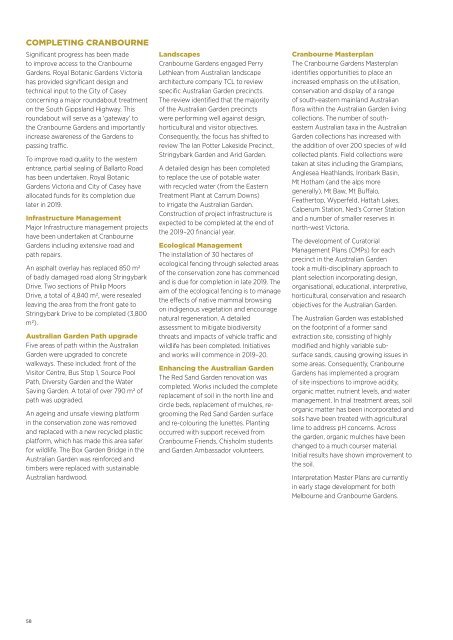Royal Botanic Gardens Victoria Annual Report 2018-19
Royal Botanic Gardens Victoria Annual Report 2018-19
Royal Botanic Gardens Victoria Annual Report 2018-19
Create successful ePaper yourself
Turn your PDF publications into a flip-book with our unique Google optimized e-Paper software.
COMPLETING CRANBOURNE<br />
Significant progress has been made<br />
to improve access to the Cranbourne<br />
<strong>Gardens</strong>. <strong>Royal</strong> <strong>Botanic</strong> <strong>Gardens</strong> <strong>Victoria</strong><br />
has provided significant design and<br />
technical input to the City of Casey<br />
concerning a major roundabout treatment<br />
on the South Gippsland Highway. This<br />
roundabout will serve as a ‘gateway’ to<br />
the Cranbourne <strong>Gardens</strong> and importantly<br />
increase awareness of the <strong>Gardens</strong> to<br />
passing traffic.<br />
To improve road quality to the western<br />
entrance, partial sealing of Ballarto Road<br />
has been undertaken. <strong>Royal</strong> <strong>Botanic</strong><br />
<strong>Gardens</strong> <strong>Victoria</strong> and City of Casey have<br />
allocated funds for its completion due<br />
later in 20<strong>19</strong>.<br />
Infrastructure Management<br />
Major Infrastructure management projects<br />
have been undertaken at Cranbourne<br />
<strong>Gardens</strong> including extensive road and<br />
path repairs.<br />
An asphalt overlay has replaced 850 m2<br />
of badly damaged road along Stringybark<br />
Drive. Two sections of Philip Moors<br />
Drive, a total of 4,840 m2, were resealed<br />
leaving the area from the front gate to<br />
Stringybark Drive to be completed (3,800<br />
m2).<br />
Australian Garden Path upgrade<br />
Five areas of path within the Australian<br />
Garden were upgraded to concrete<br />
walkways. These included: front of the<br />
Visitor Centre, Bus Stop 1, Source Pool<br />
Path, Diversity Garden and the Water<br />
Saving Garden. A total of over 790 m2 of<br />
path was upgraded.<br />
An ageing and unsafe viewing platform<br />
in the conservation zone was removed<br />
and replaced with a new recycled plastic<br />
platform, which has made this area safer<br />
for wildlife. The Box Garden Bridge in the<br />
Australian Garden was reinforced and<br />
timbers were replaced with sustainable<br />
Australian hardwood.<br />
Landscapes<br />
Cranbourne <strong>Gardens</strong> engaged Perry<br />
Lethlean from Australian landscape<br />
architecture company TCL to review<br />
specific Australian Garden precincts.<br />
The review identified that the majority<br />
of the Australian Garden precincts<br />
were performing well against design,<br />
horticultural and visitor objectives.<br />
Consequently, the focus has shifted to<br />
review The Ian Potter Lakeside Precinct,<br />
Stringybark Garden and Arid Garden.<br />
A detailed design has been completed<br />
to replace the use of potable water<br />
with recycled water (from the Eastern<br />
Treatment Plant at Carrum Downs)<br />
to irrigate the Australian Garden.<br />
Construction of project infrastructure is<br />
expected to be completed at the end of<br />
the 20<strong>19</strong>–20 financial year.<br />
Ecological Management<br />
The installation of 30 hectares of<br />
ecological fencing through selected areas<br />
of the conservation zone has commenced<br />
and is due for completion in late 20<strong>19</strong>. The<br />
aim of the ecological fencing is to manage<br />
the effects of native mammal browsing<br />
on indigenous vegetation and encourage<br />
natural regeneration. A detailed<br />
assessment to mitigate biodiversity<br />
threats and impacts of vehicle traffic and<br />
wildlife has been completed. Initiatives<br />
and works will commence in 20<strong>19</strong>–20.<br />
Enhancing the Australian Garden<br />
The Red Sand Garden renovation was<br />
completed. Works included the complete<br />
replacement of soil in the north line and<br />
circle beds, replacement of mulches, regrooming<br />
the Red Sand Garden surface<br />
and re-colouring the lunettes. Planting<br />
occurred with support received from<br />
Cranbourne Friends, Chisholm students<br />
and Garden Ambassador volunteers.<br />
Cranbourne Masterplan<br />
The Cranbourne <strong>Gardens</strong> Masterplan<br />
identifies opportunities to place an<br />
increased emphasis on the utilisation,<br />
conservation and display of a range<br />
of south-eastern mainland Australian<br />
flora within the Australian Garden living<br />
collections. The number of southeastern<br />
Australian taxa in the Australian<br />
Garden collections has increased with<br />
the addition of over 200 species of wild<br />
collected plants. Field collections were<br />
taken at sites including the Grampians,<br />
Anglesea Heathlands, Ironbark Basin,<br />
Mt Hotham (and the alps more<br />
generally), Mt Baw, Mt Buffalo,<br />
Feathertop, Wyperfeld, Hattah Lakes,<br />
Calperum Station, Ned’s Corner Station<br />
and a number of smaller reserves in<br />
north-west <strong>Victoria</strong>.<br />
The development of Curatorial<br />
Management Plans (CMPs) for each<br />
precinct in the Australian Garden<br />
took a multi-disciplinary approach to<br />
plant selection incorporating design,<br />
organisational, educational, interpretive,<br />
horticultural, conservation and research<br />
objectives for the Australian Garden.<br />
The Australian Garden was established<br />
on the footprint of a former sand<br />
extraction site, consisting of highly<br />
modified and highly variable subsurface<br />
sands, causing growing issues in<br />
some areas. Consequently, Cranbourne<br />
<strong>Gardens</strong> has implemented a program<br />
of site inspections to improve acidity,<br />
organic matter, nutrient levels, and water<br />
management. In trial treatment areas, soil<br />
organic matter has been incorporated and<br />
soils have been treated with agricultural<br />
lime to address pH concerns. Across<br />
the garden, organic mulches have been<br />
changed to a much courser material.<br />
Initial results have shown improvement to<br />
the soil.<br />
Interpretation Master Plans are currently<br />
in early stage development for both<br />
Melbourne and Cranbourne <strong>Gardens</strong>.<br />
58


